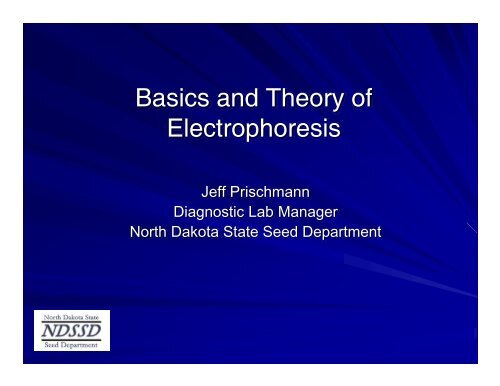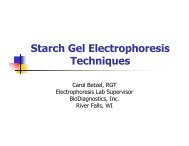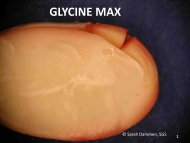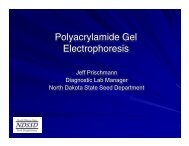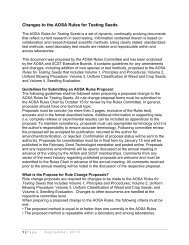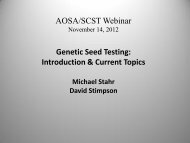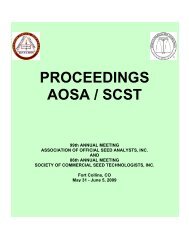Basics and Theory of Electrophoresis
Basics and Theory of Electrophoresis
Basics and Theory of Electrophoresis
Create successful ePaper yourself
Turn your PDF publications into a flip-book with our unique Google optimized e-Paper software.
<strong>Basics</strong> <strong>and</strong> <strong>Theory</strong> <strong>of</strong><br />
<strong>Electrophoresis</strong><br />
Jeff Prischmann<br />
Diagnostic Lab Manager<br />
North Dakota State Seed Department
<strong>Basics</strong> <strong>and</strong> <strong>Theory</strong> <strong>of</strong><br />
<strong>Electrophoresis</strong><br />
Basic principles<br />
History <strong>of</strong> <strong>Electrophoresis</strong><br />
Types <strong>of</strong> <strong>Electrophoresis</strong><br />
Gel <strong>Electrophoresis</strong><br />
Sample types<br />
Equipment<br />
Applications
Basic Principles<br />
What is <strong>Electrophoresis</strong>?<br />
A technique whereby charged<br />
molecules are separated by the use<br />
<strong>of</strong> an electric field.<br />
During electrophoresis, charged<br />
molecules will migrate towards an<br />
opposite charge.
Basic Principles<br />
What is <strong>Electrophoresis</strong>?<br />
A mixture <strong>of</strong> molecules <strong>of</strong> various<br />
sizes will migrate at different<br />
velocities <strong>and</strong> will be separated.<br />
<strong>Electrophoresis</strong> is usually carried<br />
out in an aqueous solution.
Basic Principles<br />
What is <strong>Electrophoresis</strong>?<br />
<strong>Electrophoresis</strong> is a commonly<br />
used technique in many scientific<br />
fields.
Basic Principles
History <strong>of</strong><br />
<strong>Electrophoresis</strong><br />
1939 Zone electrophoresis developed<br />
1950 Agar gel electrophoresis<br />
1955 Starch gel (Smithies)<br />
1957 Cellulose acetate (Kohn)<br />
1959 Acrylamide gels first used<br />
(Raymond <strong>and</strong> Winstraub)<br />
1961 IEF (Svensson)<br />
1964 Disc Gel <strong>Electrophoresis</strong> (Ornstein<br />
<strong>and</strong> Davis)
History <strong>of</strong><br />
<strong>Electrophoresis</strong><br />
1969 SDS electrophoresis (Beber <strong>and</strong><br />
Osborn)<br />
1971 SDS electrophoresis (Laemmli)<br />
1971 Cellulose acetate gels (Meera)<br />
1975 2-D electrophoresis<br />
1977 Sequencing gels first used<br />
1979 Agarose gel electrophoresis<br />
1983 Pulsed field electrophoresis<br />
1983 Capillary electrophoresis
Types <strong>of</strong> <strong>Electrophoresis</strong><br />
Free solution electrophoresis<br />
(Capillary <strong>Electrophoresis</strong>)<br />
Supporting medium electrophoresis<br />
(paper, film, various gels)
Gel <strong>Electrophoresis</strong>
Gel <strong>Electrophoresis</strong><br />
<strong>Electrophoresis</strong> that involves the<br />
use <strong>of</strong> a gelatinous material such<br />
as agarose, acrylamide, starch or<br />
cellulose acetate as the matrix.<br />
The gel acts as a support medium<br />
for the sample.<br />
Commonly used to separate<br />
samples containing proteins or<br />
DNA.
Gel <strong>Electrophoresis</strong><br />
An important purpose <strong>of</strong> a gel<br />
matrix is to introduce a sieving<br />
action which allows separations <strong>of</strong><br />
molecules based on molecular<br />
size.<br />
Gel matrix viscosity, density, <strong>and</strong><br />
pore size are all factors in<br />
determining the ‘speed’ <strong>of</strong><br />
separation.
Gel <strong>Electrophoresis</strong><br />
2 Main Types <strong>of</strong> Gels<br />
Slab gels<br />
Tube gels
Gel <strong>Electrophoresis</strong><br />
Types <strong>of</strong> Separation<br />
Native: separation by size <strong>and</strong><br />
charge (charge/mass)<br />
Denaturing: separation by size<br />
Others (IEF, 2-D)
Gel <strong>Electrophoresis</strong><br />
Native<br />
continuous system--gel <strong>and</strong> tank<br />
buffers are the same, single phase<br />
gel; examples are PAGE, agarose,<br />
<strong>and</strong> starch gels.<br />
discontinuous system--gel <strong>and</strong><br />
tank buffers are different, twophase<br />
gel (stacking gel); example<br />
is PAGE.
Gel <strong>Electrophoresis</strong><br />
Denaturing<br />
SDS (sodium dodecyl sulphate)<br />
used to denature proteins<br />
(discontinuous system).<br />
urea or formamide used to<br />
denature DNA or RNA.
Gel <strong>Electrophoresis</strong><br />
Other types<br />
Isoelectric focusing: protein<br />
separation based on isolectric<br />
points in a pH gradient.<br />
2-D electrophoresis: combination<br />
<strong>of</strong> IEF <strong>and</strong> SDS-PAGE.
Gel <strong>Electrophoresis</strong><br />
Gel Types<br />
Starch<br />
Acrylamide<br />
Agarose<br />
Cellulose acetate<br />
IEF
Gel <strong>Electrophoresis</strong><br />
Main factors that effect separation:<br />
Resistance (pore size)<br />
Buffer strength<br />
Gel Temperature<br />
Sample
Gel <strong>Electrophoresis</strong><br />
Resistance-Pore Size<br />
Gel electrophoresis units are simple DC circuits.<br />
Source: National Diagnostics
Gel <strong>Electrophoresis</strong><br />
Resistance-Pore Size<br />
Source: National Diagnostics
Gel <strong>Electrophoresis</strong><br />
Buffers<br />
Common buffer components<br />
include: acetic acid, boric acid,<br />
citric acid, glycine, phosphoric<br />
acid, tris, tricine.<br />
Ionic strength <strong>of</strong> buffers are<br />
important.<br />
Homogenous buffers vs<br />
multiphasic buffers
Gel <strong>Electrophoresis</strong><br />
Buffers<br />
Source: National Diagnostics
Gel <strong>Electrophoresis</strong><br />
Temperature<br />
Temperature management is critical to<br />
achieve good results.<br />
Some applications require maintaining<br />
a high temperature (denaturing PAGE<br />
<strong>of</strong> DNA/RNA).<br />
Other applications require a cool<br />
temperature to prevent sample<br />
degradation or gel melting.
Sample Types<br />
Proteins<br />
Nucleic Acids
Sample Types<br />
Proteins<br />
Comprised <strong>of</strong> amino acids<br />
Protein structure is described as primary,<br />
secondary, tertiary, <strong>and</strong> quaternary based<br />
on amino acid sequence, bends/spirals,<br />
shape, <strong>and</strong> multiple peptide chains.<br />
A protein’s structure affects how it is<br />
separated during electrophoresis.
Sample Types<br />
Types <strong>of</strong> Proteins<br />
Enzymes (albumins)<br />
Regulatory proteins<br />
Transport proteins<br />
Storage proteins (prolamins, globulins)<br />
Structural proteins (glutelins)
Sample Types<br />
Proteins-Amino Acids
Sample Types<br />
Proteins-Amino Acids<br />
Aspartic acid <strong>and</strong> glutamic acid impart<br />
acidic properties to proteins.<br />
Lysine, Arginine, <strong>and</strong> Histidine impart<br />
basic properties to proteins.
Sample Types<br />
Protein structure<br />
Source: www.umass.edu/molvis/workshop/prot1234.htm
Sample Types<br />
Proteins <strong>and</strong> <strong>Electrophoresis</strong><br />
Proteins are charged molecules <strong>and</strong> at<br />
neutral pH’s are either basic or acidic<br />
depending upon their AA composition.<br />
Most proteins placed into basic conditions<br />
become negatively charged. Acidic<br />
conditions cause most proteins to develop<br />
a positive charge.
Sample Types<br />
Proteins <strong>and</strong> <strong>Electrophoresis</strong><br />
Native electrophoresis <strong>of</strong> proteins<br />
generally occurs in basic conditions.<br />
Denaturing protein electrophoresis<br />
causes proteins to become negatively<br />
charged (SDS-PAGE).
Sample Types<br />
Proteins <strong>and</strong> <strong>Electrophoresis</strong><br />
Isozymes (isoenzymes): enzymes that<br />
differ in amino acid sequence but catalyze<br />
the same chemical reaction.<br />
Isozymes have different molecular<br />
weights <strong>and</strong> chemical properties <strong>and</strong> thus<br />
can be separated from each other during<br />
electrophoresis.<br />
Isozymes are coded by genes on different<br />
loci.
Sample Types<br />
Proteins <strong>and</strong> <strong>Electrophoresis</strong><br />
Allozymes: a variant form <strong>of</strong> an enzyme<br />
that is coded for by different alleles at the<br />
the same locus.<br />
Allozymes also have different molecular<br />
weights <strong>and</strong> chemical properties <strong>and</strong> can<br />
be separated using electrophoresis.
Sample Types<br />
Proteins <strong>and</strong> <strong>Electrophoresis</strong><br />
Monomeric enzymes: consists <strong>of</strong> a single<br />
polypeptide unit, each b<strong>and</strong> represents a<br />
different polypeptide coded by a different<br />
allele.<br />
Dimeric enzymes: quaternery structure<br />
consisting <strong>of</strong> 2 polypeptide units, different<br />
gel b<strong>and</strong>s represent different combinations<br />
<strong>of</strong> polypeptides.
Sample Types<br />
Source: Allozyme <strong>Electrophoresis</strong> <strong>and</strong> Population Structure in the Snowy<br />
Campion (Silene latifolia ssp. Alba). V<strong>and</strong>erbilt University.<br />
(www.cas.v<strong>and</strong>erbilt.edu/bsci111b/index.htm).
Sample Types<br />
Proteins <strong>and</strong> <strong>Electrophoresis</strong><br />
In Summary: The electrophoretic mobility<br />
<strong>of</strong> a protein is dependent upon its charge,<br />
size, <strong>and</strong> shape.<br />
The type <strong>of</strong> electrophoresis that is used<br />
affects a protein’s separation.
Sample Types<br />
Nucleic Acids <strong>and</strong> <strong>Electrophoresis</strong><br />
DNA is negatively charged (due to<br />
phosphate backbone).<br />
<strong>Electrophoresis</strong> <strong>of</strong> double str<strong>and</strong>ed DNA<br />
occurs under native gel conditions.<br />
<strong>Electrophoresis</strong> <strong>of</strong> single str<strong>and</strong>ed DNA<br />
occurs under denaturing conditions<br />
(ensures single str<strong>and</strong>ed molecules <strong>and</strong><br />
prevents base pairing).
Sample Types<br />
Nucleotide Structure<br />
DNA RNA<br />
Source: National Diagnostics
Sample Types<br />
RNA Structure<br />
Source: National Diagnostics
Sample Types<br />
DNA Structure<br />
Source: J. L. Schumann
Gel <strong>Electrophoresis</strong><br />
Main Steps<br />
Prepare samples<br />
Prepare gel <strong>and</strong> buffers<br />
Load samples onto gel<br />
Run gel<br />
Stain gel<br />
Interpret/analysis <strong>of</strong> gel<br />
Archive (photograph, dry gel)
Gel <strong>Electrophoresis</strong><br />
Results<br />
Electrophoretogram: The results <strong>of</strong> an<br />
electrophoresis test.<br />
Zymogram: b<strong>and</strong>ing pattern <strong>of</strong><br />
enzymes or isozymes after<br />
electrophoresis.
Gel <strong>Electrophoresis</strong><br />
Results<br />
Unique b<strong>and</strong>s <strong>and</strong> or b<strong>and</strong>ing<br />
patterns.<br />
Molecular weight st<strong>and</strong>ards can be<br />
ran with samples to estimate sizes.<br />
B<strong>and</strong> naming systems have been<br />
developed for some types <strong>of</strong><br />
electrophoresis.<br />
Migration or separation <strong>of</strong> a sample<br />
can be measured (Rf values)
Gel <strong>Electrophoresis</strong><br />
Source: Schuelter et al. 1999. Inheritance <strong>of</strong> Malate Dehydrogenase in<br />
Wild Pepper. Bragantia 58(1).
Power supply<br />
Equipment<br />
Cooling Apparatus<br />
<strong>Electrophoresis</strong> gel apparatus<br />
White Light/UV Light Box<br />
Digital Camera/Gel Documentation<br />
System<br />
Reagents: Gel staining chemicals, premade<br />
gel or gel chemicals, buffers, etc.<br />
General lab equipment: pH meter,<br />
pipettors, scale, stir plates, etc.
Equipment<br />
Power Supplies<br />
Power supplies vary based on type<br />
<strong>of</strong> electrophoresis <strong>and</strong> type <strong>of</strong> gel.<br />
PAGE usually uses higher voltage.<br />
Agarose gel electrophoresis<br />
generally uses lower voltage.<br />
Some applications may use either<br />
constant current, constant watts, or<br />
constant volts.
Equipment<br />
Power Supplies<br />
Constant voltage generally used for<br />
SDS-PAGE <strong>of</strong> proteins.<br />
Constant power or constant current<br />
used for many types <strong>of</strong> denaturing<br />
PAGE.<br />
Effective way to manage heat<br />
during electrophoresis is to use<br />
constant current or constant power.
Equipment<br />
<strong>Electrophoresis</strong> Gel Apparatus<br />
Vertical apparatus: used for PAGE<br />
Horizontal apparatus: used for<br />
agarose gels, starch gels, IEF.
Equipment<br />
Vertical <strong>Electrophoresis</strong> Gel Apparatus
Equipment<br />
Horizontal <strong>Electrophoresis</strong> Gel Apparatus
Equipment<br />
Digital Camera/Gel Documentation System
Applications<br />
DNA Sequencing<br />
Blotting (DNA Hybridization<br />
/Southern Blot)<br />
Medical Research<br />
Protein research/purification<br />
Agricultural testing<br />
Many others
Applications<br />
Seed Testing<br />
Variety Identification<br />
Varietal purity (identify mixtures,<br />
<strong>of</strong>f-types, etc.)<br />
GMO/Adventitious presence<br />
Testing
Applications<br />
Seed Testing-cont.<br />
Measurement <strong>of</strong> hybrid purity<br />
Identify genetic markers used by<br />
plant breeders<br />
Seed production/certification<br />
(monitor varietal purity <strong>and</strong><br />
identity)
Applications<br />
Seed Testing-cont.<br />
Quality control in processing <strong>and</strong><br />
other industries.<br />
Variety registration (PVP<br />
applications)<br />
Documentation <strong>of</strong> genetic<br />
resources in germplasm<br />
collections, etc.
References<br />
Westermeier, R. 2001<br />
<strong>Electrophoresis</strong> in Practice.<br />
Chrambach, A. 1992 Advances in<br />
<strong>Electrophoresis</strong>.<br />
Martin, 1996. Gel <strong>Electrophoresis</strong>:<br />
nucleic acids.<br />
Hames, B. 1998 Gel <strong>Electrophoresis</strong><br />
<strong>of</strong> Proteins: A Practical Approach.
References<br />
<strong>Electrophoresis</strong> journals: Journal<br />
<strong>of</strong> Separation Science (JSS),<br />
<strong>Electrophoresis</strong>.<br />
Societies: The American<br />
<strong>Electrophoresis</strong> Society<br />
(www.aesociety.org)
Questions


